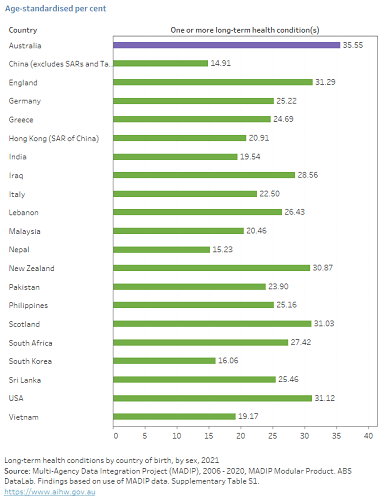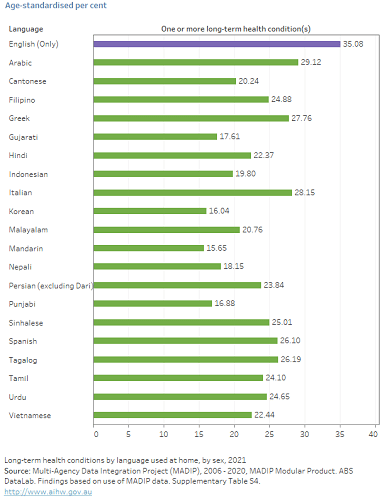Australians born in China, Nepal, South Korea, Vietnam and India show the lowest prevalence of one or more long-term health condition(s).
Australians who speak Punjabi, Gujarati, Korean and Mandarin report the lowest prevalence of chronic health conditions.
A new report released by the Australian Institute of Health and Welfare (AIHW) showed that those born in Australia, and those from English-speaking backgrounds, have a higher prevalence of long-term health conditions than other Australians.
The study conducted by the Australian Institute of Health and Welfare was based on data collected for the 2021 Census, and looked at ten chronic health conditions in 20 most common overseas countries of birth. Migrants from India were given a relatively clean bill of health, as opposed to migrants from countries such as the US, England, Germany, and New Zealand. People born in China (15%), Nepal (15%), South Korea (16%) and India (19%) had the lowest prevalence.

People born in Iraq had the highest prevalence (29%) among the non-main English speaking countries, followed by those born in Lebanon (26%) and Sri Lanka (25%).
People born in Australia had the highest prevalence of at least one long-term health condition (36%). Those who spoke Punjabi (17%), Gujarati (18%) Korean (16%) and Mandarin (16%) had the lowest prevalence.
People who spoke Arabic (29%), Italian (28%), Greek (28%) and Tagalog (26%) had the highest prevalence of one or more long-term health condition(s). People who spoke English (only) were more likely than the 20 most common non-English language population groups to report one or more long-term health condition(s) (35%).
According to the study, those born in Asian countries by and large report diabetes, heart disease and kidney disease more frequently than other conditions. Those born in Australia, English-speaking and European countries show higher prevalence of arthritis, asthma,
cancer, lung conditions and mental health conditions.
Speaking of the data for India-borns, Clinical Prof Smita Shah, Faculty of Medicine and Health, University of Sydney, told Indian Link, “At first glance these numbers do look impressive, no doubt. But I cannot refrain from offering a hint of caution. It is well-known that as a community we are prone to cardiovascular diseases and diabetes, and obesity as we age. These are common conditions I’m seeing in my own professional capacity at Western Sydney where I work. And I’m seeing them increase. So this new data must really serve to galvanise us to reduce the numbers further, with more programs for prevention. My own work is geared to arming the next generation with leadership skills towards healthy lifestyle choices, with specific emphasis on diet and exercise.”

Indeed, interesting numbers did show up for two of the leading causes of disease burden in Australia — coronary heart disease and dementia — to which migrants contribute more than their fair share. For heart disease, people born in Pakistan had the highest prevalence (4.6%), followed by those born in Iraq (4.0%) and Sri Lanka (3.9%). In comparison, people born in Australia had a prevalence of 3.6%.
For dementia, those born in Italy had the highest prevalence (0.9%), followed by those born in Iraq (0.8%) and Vietnam (0.8%). In comparison, people born in Australia had a prevalence of (0.6%) Bangladesh-born Australians had the highest prevalence of both diabetes and heart disease (12% and 4.6%, respectively).
Other parameters
Besides country of birth and language spoken at home, other parameters were also considered in the research. In terms of time since arrival, the prevalence of long-term
health conditions generally increased as the number of years since arriving in Australia increased, reducing the gap between the Australian-born and overseas-born populations. (This however did not hold true for Iraq: time since arrival made no difference, except for cardiovascular disease, kidney disease and dementia, with new arrivals showing increased prevalence). People born in New Zealand and Pakistan also had a higher prevalence for dementia for recent as compared with early arrivals.

In further breakdowns for language, Urdu speakers had the highest prevalence of diabetes (11%) and heart disease (4.8%). Arabic speakers had the highest prevalence of kidney disease (1.2%) and stroke (1.0%). In terms of proficiency in English, the prevalence was higher in those who did not speak English well or at all, compared to those who spoke it well or very well. For early arrivals (people who first arrived in Australia more than 10 years before the 2021 Census), the prevalence of one or more long-term health conditions was higher for people with low English proficiency (33%) than for people with high proficiency (23%).
Speaking about the relevance of the study, AIHW spokesperson Claire Sparke said, “Some CALD populations face inter-connected health and social disadvantages, as well as greater challenges when dealing with the healthcare system and services. Today’s report is fundamental to building a more complete picture of the health status of more than 7 million CALD people living in Australia. It will help build a clearer understanding of the health differences, enabling better design and delivery of services to ensure they can access the health and community services they require.”
Read More: Dr Abhishek Verma: GP of the Year 2022




